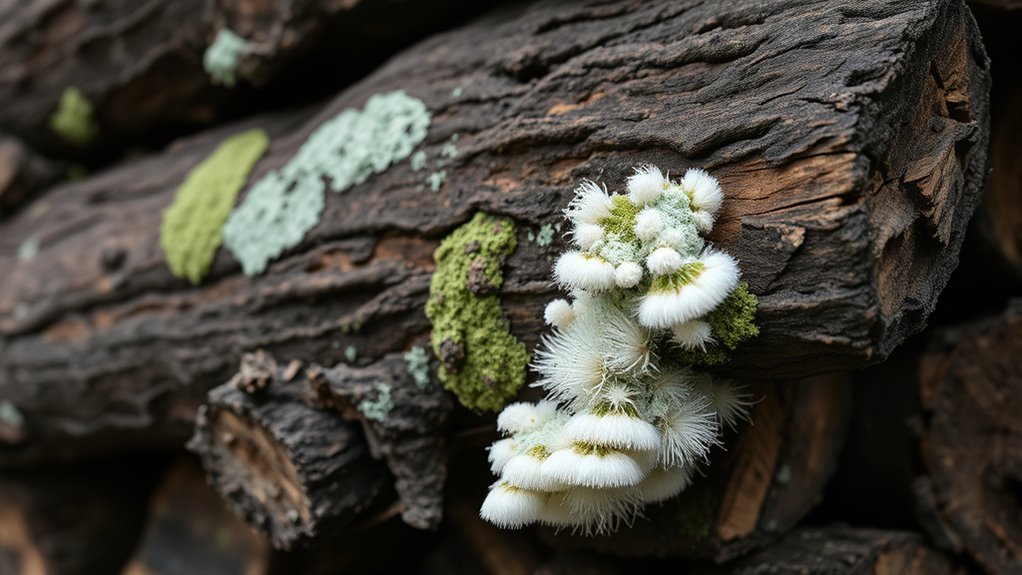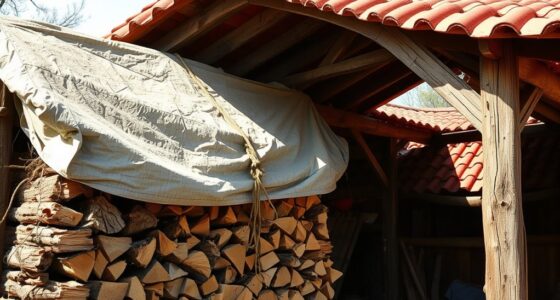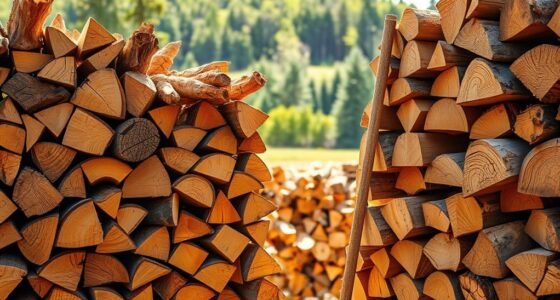To identify mold and fungus in stored logs, look for discoloration such as green, black, or white patches, fuzzy or powdery surfaces, and warping or soft spots. You might notice a musty or damp odor, and the wood may have cracks or uneven edges. High humidity and poor ventilation encourage growth. Keeping an eye on these signs and understanding environmental factors helps you spot issues early—there’s more you can do to prevent and manage them.
Key Takeaways
- Look for discoloration such as green, black, white patches, or uneven spots on log surfaces.
- Check for fuzzy, powdery, or moldy textures indicating fungal growth.
- Smell for musty, damp, or sour odors signaling mold presence.
- Inspect logs for soft spots, cracks, warping, or structural damage caused by fungi.
- Monitor environmental conditions like high humidity and poor ventilation that promote mold development.
Common Signs of Mold and Fungus on Logs
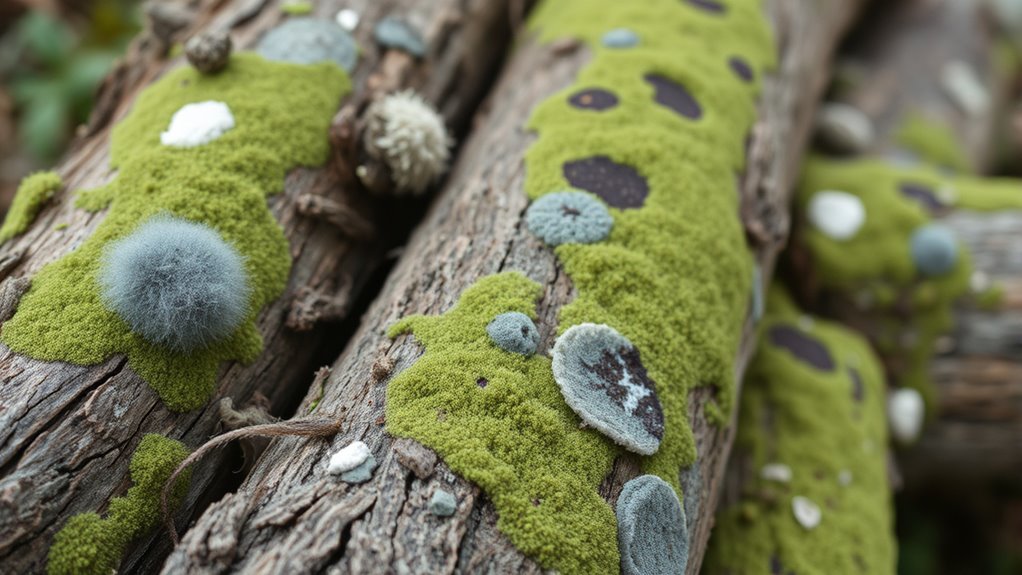
Mold and fungus on logs often reveal themselves through visible signs that you can easily spot. However, to confirm their presence, you should consider chemical testing and moisture measurement. High moisture levels in logs create the perfect environment for mold growth, so measuring moisture content helps identify problem areas early. Chemical testing can detect mold spores or fungal compounds not visible to the naked eye, providing a more accurate assessment. If your logs have consistently high moisture readings or chemical indicators of fungal activity, it’s a sign that mold is present beneath the surface. Monitoring moisture levels is essential because it directly influences mold development and helps you distinguish between harmless discoloration and active mold growth, guiding you on whether further action is necessary to prevent deterioration or health risks. Additionally, understanding the environmental factors that promote fungal growth can help you implement more effective prevention strategies. Regularly inspecting logs and maintaining proper storage conditions can significantly reduce the risk of mold proliferation. Recognizing the importance of preventive measures can also help you avoid costly repairs or health hazards associated with mold exposure. Being aware of the effects of moisture on fungal growth allows you to better control storage environments and keep logs safe.
Visual Indicators to Watch For
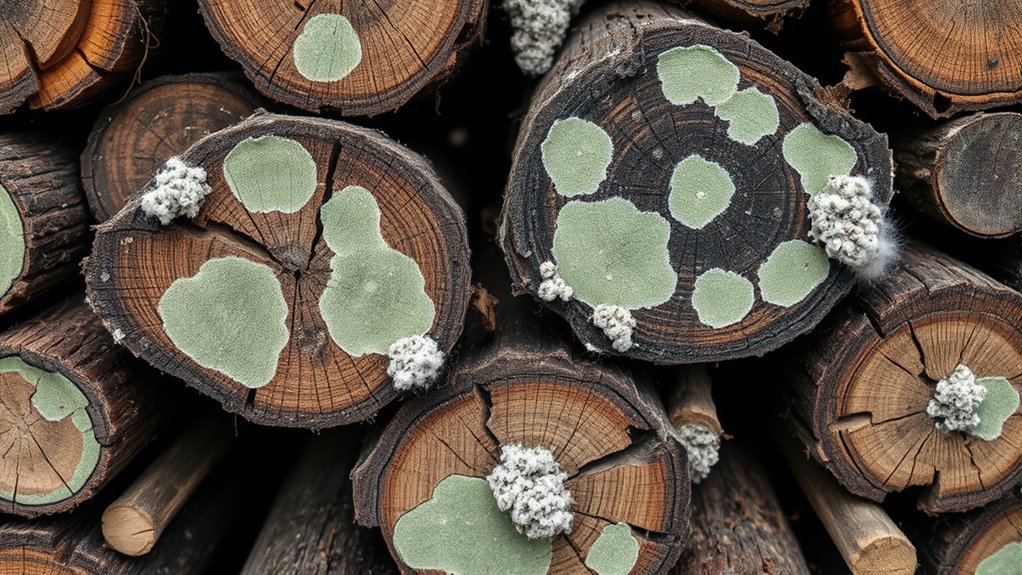
You can often identify mold and fungus on logs by noticing certain visual cues. Look for discoloration, such as green, black, or white patches, which indicate fungal growth. Fungal resistance varies among wood types; logs lacking resistance are more prone to mold spots. Check for fuzzy or powdery surfaces, as these are clear signs of fungal presence. Cracks, warping, or soft spots can also reveal underlying issues. Effective log preservation techniques, like proper drying and storage in dry, ventilated areas, help prevent visible mold development. Regular inspection is key—early detection through visual cues allows you to take action before mold spreads. Recognizing these indicators ensures you maintain healthy logs and apply appropriate preservation methods promptly. Additionally, understanding the key steps in prevention can significantly reduce mold growth over time. Maintaining proper ventilation and airflow around stored logs further minimizes the risk of mold development by reducing moisture accumulation. Implementing moisture control measures is essential for effective log preservation and preventing fungal growth.
Smell and Odor Clues
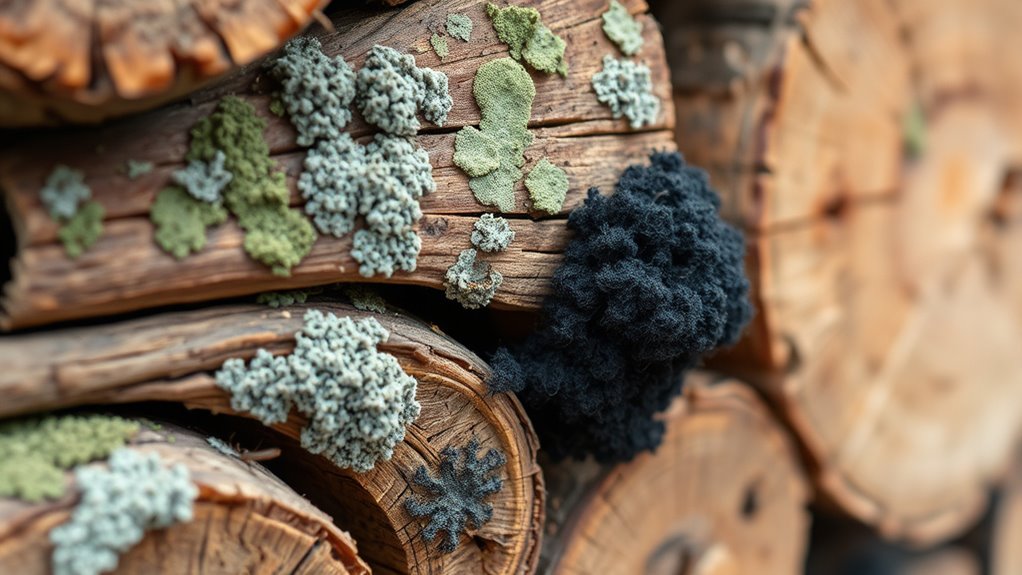
While visual signs are helpful, paying attention to smell can reveal mold and fungus lurking unseen. A musty, damp odor often signals hidden problems. To identify these issues, focus on three key clues:
- A stale, earthy smell like wet soil, indicating high moisture levels.
- A sharp, pungent scent resembling rotten fruit, hinting at fungal growth.
- A sour, vinegar-like odor, which may result from chemical testing detecting mold spores. Recognizing mold growth early can prevent further damage to your stored logs. Using a moisture meter can help confirm suspicions by detecting dampness that promotes mold development. Proper ventilation is also crucial, as it helps reduce humidity and discourage mold proliferation.
These smells often stem from excess moisture, so measuring humidity helps confirm suspicions. Moisture measurement tools can pinpoint damp areas where mold thrives. If you notice such odors, consider chemical testing to detect mold spores and prevent further damage to your stored logs. Additionally, maintaining proper air circulation can help reduce moisture buildup and inhibit mold growth.
Textural Changes in the Wood
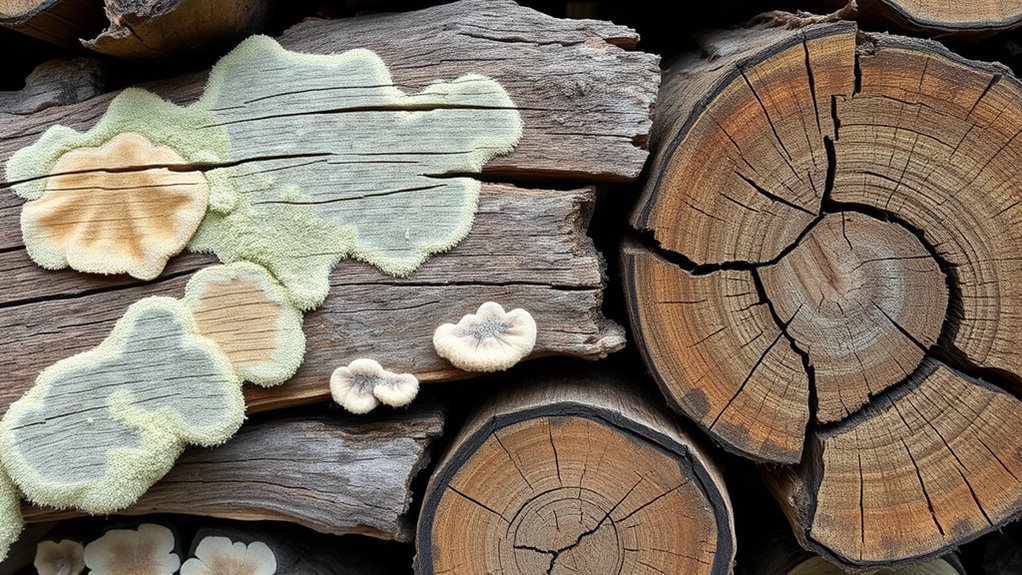
You’ll notice that mold and fungus often cause the wood to soften or warp, making it feel different under your touch. Discoloration patterns, such as dark spots or streaks, can also indicate internal changes. Paying attention to these textural clues helps you identify potential problems early.
Softening and Warping
When mold or fungus infect stored logs, they often cause noticeable changes in the wood’s texture, particularly softening and warping. You’ll notice the wood becomes less firm, losing its natural resilience. The softening can lead to structural issues, reducing the logs’ wooden durability. Warping occurs as the wood twists or bends unevenly, disrupting its shape. Visualize these changes as:
- Buckled surfaces that no longer lay flat
- Cupped or twisted edges
- Gentle sagging or drooping in the logs
These textural changes compromise the logs’ integrity and fungal resistance. Softened, warped wood signals that mold or fungus has compromised the material, making it more susceptible to further decay. Recognizing these signs helps prevent further damage and preserves the logs’ quality. Additionally, proper storage conditions can significantly reduce the risk of mold and fungus development on stored logs. Implementing adequate ventilation and controlling moisture levels are key factors in maintaining wood health. Proper moisture management is essential to prevent fungal growth and maintain the logs’ structural integrity. Incorporating exfoliation techniques, such as those provided by glycolic acid, can also help in assessing surface damage and preparing the wood for treatment or inspection. Maintaining awareness of environmental impacts on stored wood helps ensure longevity and quality.
Discoloration Patterns
Discoloration patterns are often among the first visible signs that mold or fungus has affected stored logs. These patterns reveal fungal growth indicators and help you identify issues early. Look for unusual color changes, such as dark streaks, yellowing, or grayish patches, which may signal mold presence. Fungal growth can cause irregular spots or blotches on the wood surface, often spreading unevenly. The discoloration may deepen over time, indicating active fungal activity. Patterns can vary depending on the type of fungus, so observe the shape, size, and location of the affected areas. Recognizing these discoloration patterns allows you to assess log condition promptly and take necessary action before more significant damage occurs. Additionally, understanding wood decay processes can help in identifying the severity and type of fungal infestation. Regular inspections and awareness of fungal identification techniques enhance early detection and facilitate effective remediation. Being familiar with common fungal species that affect wood can further improve your ability to respond appropriately.
Environmental Conditions Promoting Fungal Growth
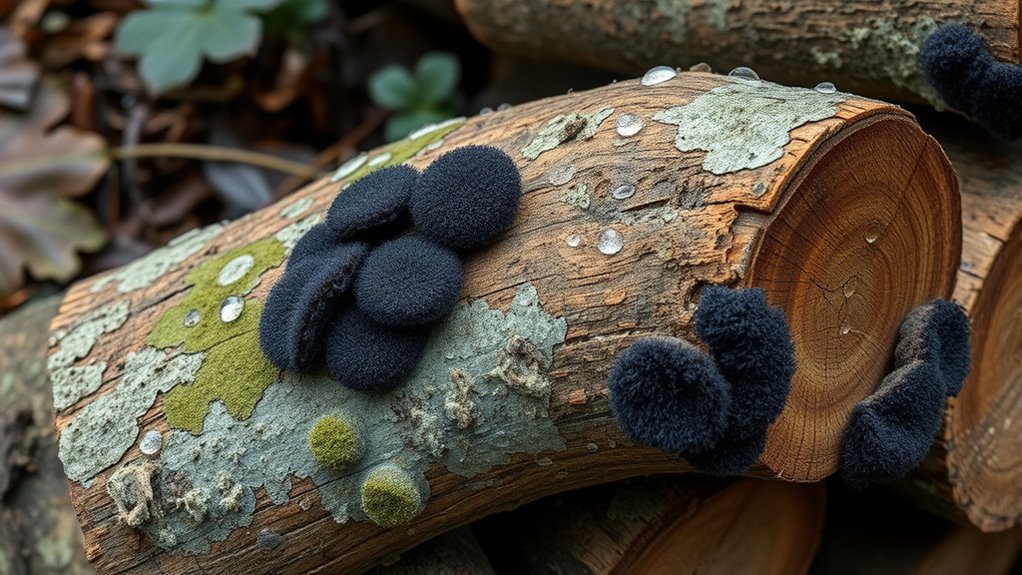
High humidity levels create ideal conditions for mold and fungus to thrive on stored logs. Poor ventilation traps moisture, making it easier for fungi to spread. Additionally, temperature fluctuations can speed up fungal growth, increasing the risk of contamination. Understanding environmental safety measures can help prevent such issues. Regularly monitoring moisture levels and maintaining proper storage conditions are essential steps in fungus prevention.
Humidity Levels Elevate Growth
Elevated humidity levels create an ideal environment for mold and fungus to thrive on stored logs. High humidity increases the moisture content, making logs more susceptible to fungal growth over time. As storage duration extends, the risk grows because damp conditions persist. Visualize your logs:
- Surface mold spreading in fuzzy patches
- Darkened, damp spots forming on the wood
- A musty smell indicating persistent moisture
These signs appear when humidity remains high, encouraging mold spores to settle and grow. Moisture content needs to stay low, especially during prolonged storage, to prevent fungal development. If humidity fluctuates or stays elevated, logs become prime targets for mold, which can compromise their quality and safety. Keeping humidity levels controlled is essential to inhibit mold growth and protect your stored logs.
Insufficient Ventilation Promotes Mold
When your logs lack proper airflow, mold can quickly take hold. Insufficient ventilation creates damp, stagnant conditions ideal for fungal growth. To prevent this, focus on ventilation improvements and log storage techniques. Elevate logs off the ground, maximize airflow around stacks, and avoid stacking logs too tightly. Consider using racks or spreading logs out to promote better air circulation. Here’s how poor ventilation affects log storage:
| Condition | Effect | Solution |
|---|---|---|
| Limited airflow | Moisture buildup | Use ventilation improvements |
| Stacked logs tightly | Reduced airflow | Increase spacing |
| Damp environment | Fungal growth | Improve log storage techniques |
| Poor air circulation | Mold development | Elevate logs, use racks |
Temperature Fluctuations Accelerate Fungi
Fluctuating temperatures can substantially speed up fungal growth on stored logs. When log temperature varies, it creates ideal conditions for fungal proliferation. As the temperature swings, the environment repeatedly shifts between damp and dry states, encouraging mold spores to settle and thrive. Imagine these scenarios:
- Logs exposed to daytime heat and nighttime coolness, causing moisture to condense.
- Sudden temperature spikes, raising log moisture levels temporarily.
- Cool mornings followed by warm afternoons, trapping humidity within the wood.
These fluctuations disrupt stable conditions, making logs more susceptible to mold and fungus. The inconsistent log temperature accelerates fungal proliferation, increasing the risk of mold growth. To prevent this, maintain a steady, cool environment for your stored logs, reducing the chances of mold development.
Methods for Inspecting Stored Logs Effectively
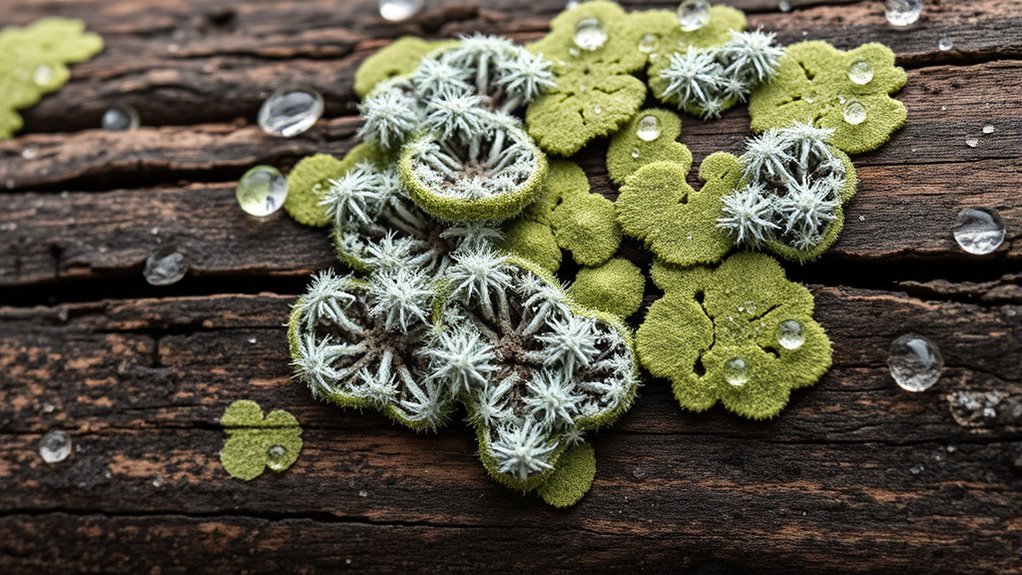
To inspect stored logs effectively, you need a systematic approach that allows you to detect mold and fungus early. Begin by regularly examining logs for visible signs like discoloration, fuzzy growth, or musty odors. Use good lighting and wear gloves to handle logs safely. Implement proper storage techniques, such as elevating logs off the ground and controlling humidity, to minimize mold risks. When you notice potential issues, consider log treatment options like drying logs thoroughly or applying fungicides if appropriate. Keep detailed records of inspections and any treatments performed. Consistent monitoring helps catch problems early, making it easier to prevent widespread mold growth. Combining vigilant inspection with effective storage techniques is your best defense against fungal contamination.
Frequently Asked Questions
How Long Does Mold Take to Develop on Stored Logs?
Mold can develop on stored logs within as little as 24 to 48 hours if moisture levels are high. Log moisture is a critical factor, so keeping logs dry helps prevent mold growth. To guarantee mold prevention, store logs in a cool, well-ventilated area and avoid stacking them directly on the ground. Regularly check your logs for signs of mold to catch issues early and maintain their quality.
What Are the Health Risks of Mold in Stored Logs?
Mold in stored logs can pose health risks by impacting your indoor air quality. When mold spores become airborne, they can trigger allergic reactions, causing symptoms like sneezing, coughing, and respiratory issues. Prolonged exposure may worsen asthma or lead to other health problems. To protect yourself, guarantee proper ventilation and moisture control, and remove mold-infested logs promptly. Staying vigilant helps prevent mold from compromising your indoor environment and your health.
Can Mold on Logs Be Completely Eradicated?
You can’t fully eradicate mold on logs, but effective mold removal techniques help control the growth and preserve the logs. To do this, you should clean the logs thoroughly, improve ventilation, and store them in dry, well-ventilated areas. Proper log preservation methods reduce moisture, making it harder for mold to thrive. Although complete removal isn’t always possible, these steps considerably limit mold development, ensuring your logs stay in good condition.
Are Certain Wood Types More Prone to Mold Growth?
Certain wood species are more prone to mold growth, especially when their moisture content is high. Softwoods like cedar and pine tend to absorb more moisture, creating ideal conditions for mold. In contrast, hardwoods such as oak and maple usually have lower moisture content and resist mold better. To prevent mold, you should monitor the wood species and keep moisture levels low, ensuring proper storage conditions.
How Should I Dispose of Moldy or Fungus-Infected Logs?
Think of moldy logs as ticking time bombs that need careful handling. To dispose of infected logs, wear gloves and a mask to protect yourself. Proper log treatment involves soaking logs in a bleach solution or exposing them to sunlight before disposal. For widespread contamination, follow local regulations for disposal methods—typically, burning or hauling logs to a designated waste facility guarantees safe removal and prevents mold spread.
Conclusion
By staying vigilant and knowing what to look for, you can spot mold and fungus on your stored logs before they spread. Keep an eye out for visual changes, unusual smells, and texture shifts, especially in damp environments. Regular inspections are your best defense—remember, an ounce of prevention is worth a pound of cure. Catching these issues early will save you headaches down the road and keep your logs in top shape.
